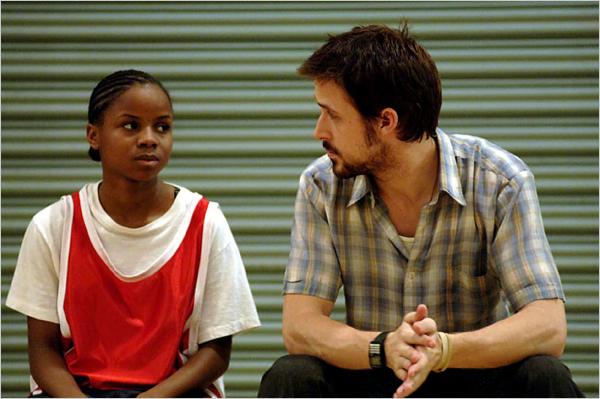Movie review by Greg Carlson
All the expected baggage that comes with the “white teacher touches lives in inner city school” set-up of “Half Nelson” evaporates in the first reel of Ryan Fleck and Anna Boden’s remarkably restrained narrative feature, an expansion of their award-winning short piece “Gowanus, Brooklyn.” Smart enough to leave plenty of questions unanswered and many stones unturned, “Half Nelson” has an uncanny grasp of the dangers of its genre’s cliché-ridden booby traps, and avoids them all. The result is an absolutely engrossing drama that ranks among the year’s finest films.
In the movies, scenes featuring classroom teaching often veer into alien territory, as inspiring speeches and light-bulb epiphanies replace the more familiar routines of daily instruction. “Half Nelson,” like many other films that take the viewer to school, pairs the messages and metaphors of its lesson plans with the after-hours action happening to the main character. Ryan Gosling, equaling or bettering his terrifyingly good performance in “The Believer” hits a grand slam as Dan Dunne, a smart, left-leaning idealist who riffs on dialectics to his middle school charges by day and smokes crack by night.
Gosling’s brilliance is matched by young costar Shareeka Epps, who plays Dunne’s student Drey, a quiet and intense eighth grader struggling to come to terms with an absentee father, an incarcerated older brother, and a mom pulling double shifts to make ends meet. Drey discovers Dunne, obliterated and pipe in hand, in the locker room following a basketball game. Rather than spill the beans, Drey keeps the information to herself, and her silence has the uneasy effect of constructing a peculiarly adult relationship with the teacher she admires and respects.
One expects that Dunne’s self-destructive personal choices will impact his teaching and imperil his job, but the filmmakers are shrewd enough to tone down the melodrama to the extent that an almost Bressonian austerity settles over the film. The technique heightens the tension, as we wait nervously for Dunne’s addiction to catch up with him. In one incisive scene, Dunne confronts Frank (Anthony Mackie), a dealer in the process of luring Drey into his employ. Faced with the double standard of his own awful role-modeling behavior, Dunne backs off, confused and shaken.
In the margins, “Half Nelson” quietly builds a second set of thematic concerns, as the filmmakers play show-and-tell with archival footage of stories including the murder of Harvey Milk and the U.S. support of Augusto Pinochet. A glimpse of Dunne’s liberal parents, who choose to step lightly around the elephant of their son’s drug dependency, offers a few hints at the circumstances of the young teacher’s downward spiral. Underscoring the scene is Rosey Grier’s performance of “It’s All Right to Cry,” which for some, calls to mind the killing of Robert Kennedy (Grier was a friend of the senator, and prevented Sirhan Sirhan from firing additional shots by placing his thumb behind the trigger of the murderer’s weapon). For others, the use of a track from “Free to Be… You and Me” alludes to that recording’s impact on a generation. The album’s messages of empowerment, equality, and tolerance inspired fierce idealism in many who came of age in the 1970s.
